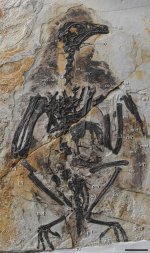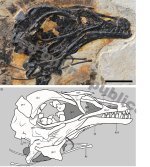Fred Ruhe
Well-known member

Min Wang, 2023
A new specimen of Parabohaiornis martini (Avialae: Enantiornithes) sheds light on early avian skul
Vertebrata PalAsiatica DOI: 10.19615/j.cnki.2096-9899.
Abstract and free pdf:
The Enantiornithes is the most speciose clade of Mesozoic avialans with over 60 named taxa reported from most continents that span the whole Cretaceous. Most of the fossil remains of this clade, as well as those of other early diverging avialans, are preserved in two-dimensions. This complicates efforts to extract detailed anatomical information from the skull, in which the composite elements are delicate and thus not easily observable through conventional methods. The scarcity of well-preserved early avialan skulls, as well as the limited number of specimens that have been analyzed using computed tomography scanning, consequently circumscribes a large morphological gap in the fossil record during the transition from the heavy and akinetic dinosaurian skull to the lightweight and kinetic bird skull. Here, we present a three-dimensional digital reconstruction of the skull and part of the cervical vertebrae of a new specimen of the enantiornithine Parabohaiornis martini from the Early Cretaceous of China. Our results demonstrate that Parabohaiornis retains the plesiomorphic, non-avialan, dinosaurian temporal and palatal configurations, reinforcing the recent hypothesis that the temporal and palatal regions are evolutionarily conservative and that the akinetic skull has been conserved well into diversification of early branching avialans.
Enjoy,
Fred
A new specimen of Parabohaiornis martini (Avialae: Enantiornithes) sheds light on early avian skul
Vertebrata PalAsiatica DOI: 10.19615/j.cnki.2096-9899.
Abstract and free pdf:
The Enantiornithes is the most speciose clade of Mesozoic avialans with over 60 named taxa reported from most continents that span the whole Cretaceous. Most of the fossil remains of this clade, as well as those of other early diverging avialans, are preserved in two-dimensions. This complicates efforts to extract detailed anatomical information from the skull, in which the composite elements are delicate and thus not easily observable through conventional methods. The scarcity of well-preserved early avialan skulls, as well as the limited number of specimens that have been analyzed using computed tomography scanning, consequently circumscribes a large morphological gap in the fossil record during the transition from the heavy and akinetic dinosaurian skull to the lightweight and kinetic bird skull. Here, we present a three-dimensional digital reconstruction of the skull and part of the cervical vertebrae of a new specimen of the enantiornithine Parabohaiornis martini from the Early Cretaceous of China. Our results demonstrate that Parabohaiornis retains the plesiomorphic, non-avialan, dinosaurian temporal and palatal configurations, reinforcing the recent hypothesis that the temporal and palatal regions are evolutionarily conservative and that the akinetic skull has been conserved well into diversification of early branching avialans.
Enjoy,
Fred
Last edited:





